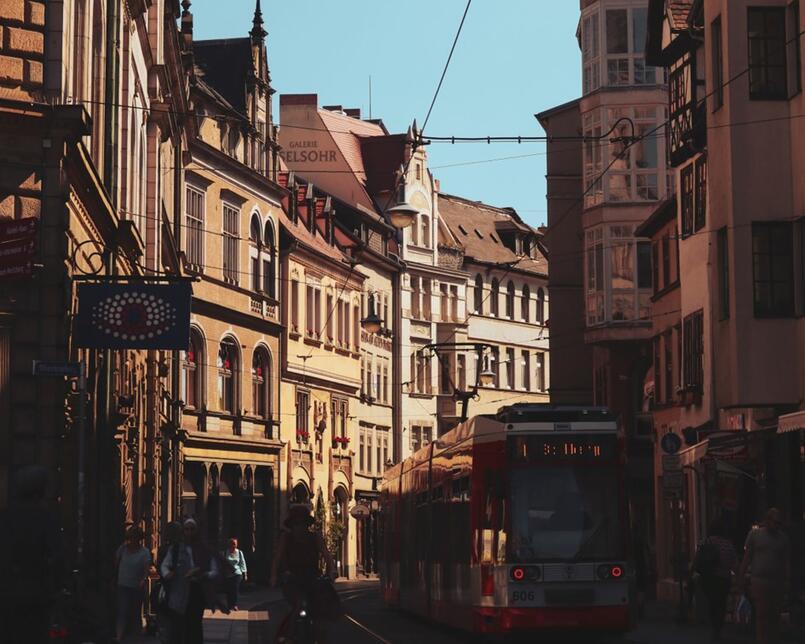Almost half of Halle’s Jewish community is aged 60 or over; under 12% are children
Dr Jonathan Boyd
and test your family's knowledge of Jews worldwide while reading the Haggadah!
Dr Jonathan Boyd
In the centre of the German city of Halle, in ‘Jerusalemer Platz,’ stands a gated doorway surrounded by yellow brick. It is not attached to anything; it leads nowhere. You can walk around it, looking through the portal from either side, into emptiness. Whatever it once led into no longer exists.
A black slate next to it explains. Written in German and Hebrew, it reads: “On this spot stood successively four synagogues of the Halle Jewish community, established in 1702. On the night of 9 November 1938, the last synagogue was destroyed and burned by the Nazis. Citizens of Halle – stay alert. Remember and do not forget.”
One wants to believe that the portal is the original entrance to the synagogue that was built here by the twelve Jewish families who settled in Halle in 1688, or to one of the successor synagogues. But it isn’t. It’s a reconstruction built in 1984. Nothing original survives.
In truth, the Jewish community of Halle traces its history back to the eleventh or twelfth century. It went through several waves of construction and destruction during the medieval period, before reconstituting itself at the turn of the eighteenth century. By the time Hitler came to power in 1933, there were over 1,000 Jews living there. Community data from 1946 states “about 65” were left.
But like their forebears, the survivors rebuilt, consecrating a new synagogue in 1953 in another part of the city, on Humboldtstrasse. The building had previously served as the funeral hall of the adjacent Jewish cemetery, before being used by the Nazis as one of several Jewish premises in Halle in which to ghettoise the city’s Jews.
Yet the aura of death was difficult to overcome; when the Berlin Wall fell in 1989, just five elderly members remained. The Halle Jewish community was all but gone.

However, extraordinarily, the collapse of the Soviet Union changed everything. Jews from the FSU were permitted to settle in Germany. But under the terms of the 1991 Quota Refugee Law they couldn’t choose where they wanted to live in the newly reunified country; instead they were distributed among the country’s states. And so, by 2004, the Jewish community of Halle in the state of Saxony-Anhalt had 731 members.
In fact, for a short period around the turn of the 21st century, Germany had the fastest growing Jewish population in the world. But following years of oppression in the Soviet Union, many Jews who came from there arrived with deeply fragmented Jewish identities. Thus, in spite of the population boost, building and sustaining Jewish life in Germany has been tough. According to official German Jewish community statistics, today the Halle community has 555 members, almost half of whom are aged 60-plus. Only 66 are aged 18 or under.
It was this community that was brutally attacked on Yom Kippur. The fifty or so local congregants in the Humboldtstrasse Synagogue that day, bolstered by a dozen or so young Jewish expats from the US and a smattering of others, survived the assault largely by luck; despite their assailant’s best attempts to shoot his way through the door, he couldn’t break through. Two non-Jewish bystanders were less fortunate: the killer gunned down a forty-year-old woman as she approached him on the street, and shot dead a twenty-year-old man in a nearby kebab shop.
So now there is a second Jewish portal in Halle rich in symbolism. A second door, this one still intact and attached to a small functioning synagogue, but scarred by gunfire.
But the demographer in me says that the door of the Humboldstrasse Synagogue may well be heading for a similar destiny to the portal on Jerusalemer Platz. Statistically, communities with such small numbers and top-heavy age structures simply don’t have a long-term future. The sociologist in me concurs: few community members are likely to have robust enough Jewish identities to successfully negotiate the challenges of modernity, never mind the trauma of an antisemitic assault. So as much as the romantic in me wants to believe that Halle’s Jews in 2019 can rebuild like Halle’s Jews of the past, I seriously doubt it. Socio-demographic trends are against them; the impact of the attack only makes matters worse.
The future of Jewish life in places like Halle is extremely precarious even without antisemitism; it will take an extraordinary effort now, both from Jews and German authorities, to secure it.
Executive Director
Executive Director
Jonathan has been Executive Director of JPR since 2010, having previously held research and policy positions at the JDC International Centre for Community Development in...
Read more